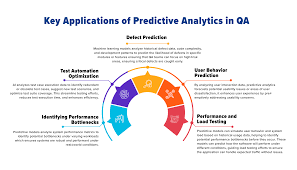Predictive analytics has become increasingly important to businesses as they continue to make more data-driven business-critical decisions. As information is now the new oil, corporations are looking for value from raw data. Machine learning (ML) is what it’s all about here. Machine learning algorithms – that know how to look for patterns in large sets of data – are turning predictive analytics from a static tool into a dynamic powerhouse for real-time decision making. This article explores how machine learning integrates with predictive analytics, the benefits it brings, and what the future holds for this powerful combination.

What is Predictive Analytics?
Predictive analytics refers to the use of statistical techniques and machine learning models to predict future outcomes based on historical data. It answers questions like:
- What will likely happen next?
- What trends can we expect in customer behavior?
- How can we anticipate risks or opportunities?
Commonly used in sectors like finance, healthcare, marketing, and logistics, predictive analytics helps organizations anticipate changes and plan accordingly.
Understanding Machine Learning in Context
Machine learning is a subset of artificial intelligence (AI) that enables systems to learn from data and improve their performance without explicit programming. ML algorithms are designed to identify patterns, make decisions, and improve accuracy over time.
Key Types of Machine Learning
- Supervised Learning: Models are trained on labeled data. Common in fraud detection and customer churn prediction.
- Unsupervised Learning: Finds hidden patterns in data without labeled outcomes. Useful in customer segmentation.
- Reinforcement Learning: Learns from interactions with an environment. Applied in dynamic pricing and recommendation engines.
The Synergy Between Machine Learning and Predictive Analytics
Machine learning enhances predictive analytics in several key ways:
1. Improved Accuracy
Traditional statistical models can falter with large or unstructured data. Machine learning models, especially deep learning, can process high-dimensional data and uncover complex patterns that enhance prediction accuracy.
2. Real-Time Processing
Machine learning models can be integrated into systems for real-time analysis. For example, fraud detection in banking uses ML to flag suspicious transactions as they happen.
3. Scalability
ML algorithms scale effortlessly with the growth of data. Whether it’s millions of user interactions or terabytes of sensor data, machine learning systems adapt without performance degradation.
4. Automation and Efficiency
Machine learning automates the model training process. AutoML tools, for example, allow users with limited data science knowledge to build accurate predictive models.
Real-World Applications
Healthcare
- Predict disease progression and treatment outcomes
- Analyze patient data for early diagnosis
Finance
- Credit scoring and loan default prediction
- Real-time fraud detection
Retail and E-commerce
- Customer purchase prediction
- Inventory demand forecasting
Manufacturing
- Predictive maintenance of machinery
- Quality assurance based on production data
Marketing
- Customer segmentation and behavior analysis
- Personalized content and campaign targeting
Challenges and Considerations
Despite its potential, there are challenges in applying ML to predictive analytics:
1. Data Quality
Poor-quality or biased data can lead to inaccurate predictions. Data preprocessing and cleaning are critical steps.
2. Model Interpretability
Many ML models, especially deep learning, are “black boxes.” Businesses often require explainable AI to build trust and comply with regulations.
3. Ethical and Privacy Concerns
Using personal data must be done with transparency and compliance with laws like GDPR and CCPA.
4. Skill Gap
Implementing ML requires skilled data scientists, which many organizations still lack.
Future Trends: AI, Data Analytics, and Automation in Sales
The integration of machine learning into predictive analytics is setting the stage for a more automated, intelligent future, especially in sales and marketing.
Predictive Sales Analytics
ML models predict lead conversion probability, recommend next best actions, and even forecast quarterly revenues.
Personalized Customer Journeys
Data-driven personalization tailors offers, messaging, and content to individual customers, improving engagement and ROI.
Intelligent Automation
CRM systems integrated with ML can automate follow-ups, prioritize leads, and suggest upsell opportunities.
Cross-functional Insights
Sales teams benefit from predictive insights derived from cross-channel customer behavior, market trends, and competitor data.
Best Practices for Implementation
- Start with clear objectives: Define what you want to predict and why it matters.
- Invest in data infrastructure: Ensure data is accessible, clean, and secure.
- Select the right tools: Use platforms like TensorFlow, scikit-learn, or cloud services with AutoML.
- Build a multidisciplinary team: Combine domain experts, data scientists, and engineers.
- Measure and refine: Continuously monitor model performance and retrain as needed.
Machine earning is transforming predictive analytics into a more precise, scalable, automated process. For businesses, this is about more than predicting the future, it’s about proactively shaping it. Regardless of your industry healthcare, retail, finance or sales there is potential for smarter decisions, using data from predictable models, combined with those derived from machine learning.
Looking towards the future, AI, data analytics and automation will be at the forefront of reshaping the way businesses do business, interact with customers and meet their strategic objectives.
Organizations that embrace these tools early will lead the next wave of innovation and efficiency.
FAQ: Machine Learning in Predictive Analytics
What is the role of machine learning in predictive analytics?
Machine learning enhances predictive analytics by increasing accuracy, enabling real-time insights, and automating the modeling process.
How does machine learning improve predictive accuracy?
ML algorithms can analyze large, complex datasets and uncover non-linear relationships that traditional models may miss.
Can small businesses use machine learning for predictive analytics?
Yes. Many cloud-based tools and platforms offer user-friendly ML capabilities accessible to small and medium-sized businesses.
Is machine learning better than traditional statistical models?
Not always. ML excels with large, unstructured data and complex patterns, while statistical models can be more interpretable and sufficient for smaller datasets.
What tools are commonly used for machine learning in predictive analytics?
Popular tools include Python libraries (scikit-learn, XGBoost), TensorFlow, AWS SageMaker, Google AutoML, and Microsoft Azure ML.
What industries benefit most from predictive analytics powered by ML?
Finance, healthcare, retail, manufacturing, and marketing are among the top industries leveraging this technology for competitive advantage.